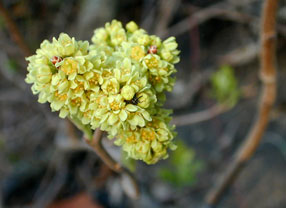FRAGRANT SUMAC
|
 |
| File Size: 57 KB |
|
|
|
Rhus aromatica Aiton
|
| Konza Prairie, Riley County, Kansas |
| Height: 2-8 feet |
| Family: Anacardiaceae - Cashew Family |
| Flowering Period: March, April, May |
|
| Also Called: | | Aromatic sumac. | | Trunks: | | Many stems from single base; branches ascending; bark dark reddish-brown, smooth or with shallow fissures. | | Twigs: | | Reddish brown to grayish brown, glabrous or pubescent, flexible; leaf scars U-shaped; buds concealed bt petiole bases. .04 to .06 inch. | | Leaves: | | Alternate, stalked, 3-foliolate, 1 to 3 inches long, 1.2 to 2.8 inches wide, yellowish-green to bluish-green, glabrous to sparsely hairy on lower surface; leaflets variable, nearly sessile, egg-shaped to rhomboid; margins scalloped or with rounded teeth; terminal leaflet largest, fan-shaped, 3-7-lobed; tips rounded or blunt. | | Flowers: | | Inflorescences terminal, head-like or irregular clusters of small flowers, .8 to 2.4 inches long, .4 to 1.6 inch wide. Staminate and pistillate flowers on different plants or with some perfect flowers; flowers less than 1/10 inch broad, pale yellow; stalks short; sepals 5, united at base, reddish brown; petals 5, distinct, yellow, usually hairy on inner surface; stamens 5; anthers small, yellow. The flowers open before the leaves or with the unfolding leaves. | | Fruit: | | Drupes appearing in June and July, spherical, 1/5 to 1/4 inch in diameter, bright red, densely long-hairy, containing single nutlet; nutlet oval or bean-shaped, about 1/6 inch long, smooth, reddish-brown. | | Habitat: | | Prairie ravines, rocky wooded hillsides, glades; sandy or gravelly soils. | | Distribution: | | Throughout Kansas. | | Origin: | | Native | | Uses: | | Native Americans applied a poultice of the roots to boils and mixed the leaves with tobacco to smoke. The leaves were also used in treatments of colds. The fruits were used to treat toothaches and the flu. During the winter, small mammals, turkeys, grouse, robins, and flickers eat the seeds and rabbits and mice eat the bark. The thickets provide wildlife cover. | | Comments: | | Fragrant sumac is a highly variable species that forms thickets up to 10 feet across. The leaves have a very unpleasant odor when crushed, which the common name skunk bush alludes to. The leaves fade orange to red or purple in the autumn. |
|
| Fragrant sumac inflorescence |  | | 63 KB | | Konza Prairie, Riley County, Kansas |
| | Fragrant sumac leaves |  | | 59 KB | | Konza Prairie, Riley County, Kansas |
| | Fragrant sumac |  | | 73 KB | | Russell County, Kansas |
| | Fragrant sumac fruit |  | | 106 KB | | Russell County, Kansas |
| | Fragrant sumac fruit |  | | 90 KB | | Russell County, Kansas |
| | Fragrant sumac inflorescence |  | | 95 KB | | Barber County, Kansas |
| | Fragrant sumac flowers and leaflets |  | | 75 KB | | Montgomery County, Kansas |
| | Fragrant sumac bud |  | | 31 KB | | Morris County, Kansas |
| | Fragrant sumac bud |  | | 29 KB | | Morris County, Kansas |
| | Fragrant sumac bud |  | | 16 KB | | Morris County, Kansas |
| | Fragrant sumac catkins |  | | 39 KB | | Konza Prairie, Riley County, Kansas |
| | Fragrant sumac catkins |  | | 39 KB | | Konza Prairie, Riley County, Kansas |
| | Fragrant sumac bark |  | | 92 KB | | Konza Prairie, Riley County, Kansas |
| | Fragrant sumac |  | | 35 KB | | Konza Prairie, Riley County, Kansas |
| | Fragrant sumac habit |  | | 191 KB | | Konza Prairie, Riley County, Kansas |
| | Fragrant sumac fruit |  | | 135 KB | | Konza Prairie, Riley County, Kansas |
| | | | |
|
|
|


















